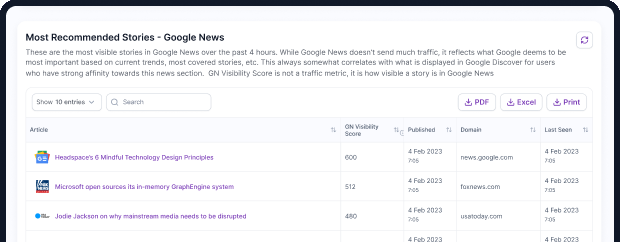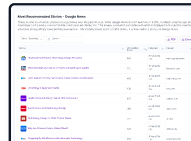Webinar: How AI Is Reshaping News Visibility—And What To Do About It

Q&A: How AI Is Reshaping News Visibility, And What To Do About It?
This article summarizes a recent webinar on how AI is transforming news visibility, featuring insights from prominent industry experts. The discussion, presented in a Q&A format, covers the evolving landscape of search, content optimization, revenue diversification, and the role of AI within news organizations.
Panelists:
- John Shehata: Founder of NewzDash (Moderator)
- Jess Scholz: Marketing Consultant, SEO Futurist, Keynote Speaker, former CMO at RingDNA
- Mike King: Founder of iPullRank, USA Today Top 10 SEO, Search Marketer of the Year, Author of "The Science of SEO" (upcoming), Founder of SEO Week Conference
- Harry Clarkson-Bennett: SEO Director at The Telegraph, SEO nerd and content lover
- Krishna Madhavan: Principal Product Manager Senior Director of Microsoft AI, Bing, Web Data Platform, PhD in AI and ML, managing or behind IndexNow
---
Q: What is happening in search with AI, and why should we care?
Mike King: Google is shifting towards a more conversational search direction. This is evident with AI Overviews appearing directly at the top of the search experience and an AI mode that functions much like ChatGPT within Google. It seems highly probable that this will become the primary version of Google in the near future. The key change is that search rankings have moved from deterministic to probabilistic. Previously, what you put in came out the same. Now, with AI Overviews and AI mode, Google makes many decisions about the content as it stitches together a response. The goal is to answer questions as quickly as possible, addressing the "delphic cost of web search"—the high cognitive load users experience when searching. This will lead to a significant reduction in clicks from search.
---
Q: From a Microsoft perspective, when do search engines decide to display AI?
Krishna Madhavan: The fundamental shift is that user intent matters more than ever before. Content doesn't just rank; it has to resonate. In Bing, the decision to display an AI summary or trigger Copilot search is highly dependent on the context and the user's intent. For instance, a simple query like "New York City pizza" can lead to different treatments based on subsequent conversational cues, demonstrating hyper-personalization enabled by LLMs. When a query, such as "Donald Trump latest news," signals an intent to understand news comprehensively, the system may provide an AI summary. However, for breaking news where real-time information is sought, a summary might not be triggered. Multiple LLMs and calls work in the background to make this cohesive decision, also factoring in what's happening across the web.
---
Q: Do you think Generative Engine Optimization (GEO) is the same as SEO, or is it a different field?
Jess Scholz: I view GEO as a development of what we've already been doing in SEO. While the current changes are bigger than previous shifts like the mobile revolution, it's still an evolution. Our core job as SEOs—connecting people to content—remains unchanged. What's fundamentally changing are the mechanisms and technologies. SEO has long adapted to include aspects beyond traditional search, such as Google Discover and user experience, so incorporating AI is another step in that progression. There's no inherent need to rename it.
---
Q: How do news organizations view this new AI landscape, including AI answers, summaries, and AI mode?
Harry Clarkson-Bennett: Initially, everyone is worried. A significant part of our role as SEOs in news organizations is now to manage this fear and help navigate the changes. This is clearly the biggest and most seismic shift the industry has faced, with massive investment in AI. Search and Google Discovery are already somewhat "black boxes," and AI adds another layer of complexity. Most publishers are observing drops in top-of-the-funnel content clicks from AI overviews, despite impressions increasing. While top-of-funnel clicks have been declining for some time, this new reality necessitates a strategic plan rather than panic. Publishers need to figure out how to diversify quickly and build their own channels, as many are reliant on search.
---
Q: What are the things that SEOs need to learn to equip them for this new era?
Mike King: SEOs need to learn and actively implement the things they claim to be doing but often aren't. For example, many claim to do semantic optimization, but their tools and processes don't support it effectively. The core challenge is optimizing at a passage level, which current SEO tools largely fail to address. Despite the wealth of information from sources like the DOJ antitrust trial testimony and leaked documents, there's not enough significant change in how SEO is practiced. Those who argue "it's just SEO" are often referring to a form of SEO that isn't actually being executed. SEOs need to educate themselves and even build custom solutions to genuinely support these new optimization requirements.
---
Q: In this new era, there's an unwritten agreement that search will take our content and send us traffic. However, now, some publishers are considering stopping writing informational queries because they believe it won't send them any traffic. What do you say to SEOs and publishers who are terrified that they'll see more impressions but much fewer clicks?
Krishna Madhavan: We completely understand the fear. The biggest difference in content now is that the previous notion of long-tail content, where any small piece indexed could be served, has changed. The narrative is now around authenticity, local relevance, and being a voice in your community. AI engines are understanding news intent more deeply. Content gets repositioned within the larger context of why people are retrieving information. For instance, weather queries can be associated with travel planning, leading to alerts about local railway strikes. This hyper-personalization means the traditional "one size fits all" approach to information has fundamentally shifted. However, the value of authentic, real, locally grounded content has not changed; how people find and interact with it is evolving.
---
Q: What is your advice on how news publishers should tackle their revenue challenge in this new era?
Jess Scholz: The key is revenue diversification. While banner ads have been a necessary evil, they were never truly enjoyed by users. Publishers should explore monetizing content through user subscriptions, newsletters, and other channels. While these might not replace the 80% revenue share banner ads once held, diversification provides a much more solid foundation. The "bus rule" applies: if your entire business crumbles because one revenue stream disappears, you don't pass. Diversification offers the comfort of lead time, allowing for thoughtful strategy rather than panicked overreaction or underreaction.
---
Q: Should news organizations block LLM crawlers?
Harry Clarkson-Bennett: This comes down to revenue and sustainability. If a publisher is sustainable enough, blocking LLM traffic and companies can be a strategic move to generate deals for data usage. You're unlikely to sign a deal with an AI partner unless you're being "punchy" with your blocking rules and access rights. For a payroll publisher like The Telegraph, being sustainable enough to block bots in the short term allows them to pursue sales opportunities. If you have data that is particularly valuable or structured (like Reddit's content for training models), leveraging that as a sales opportunity now is crucial, as the AI landscape is rapidly changing. The Telegraph, as far as he's aware, is trying to implement this at the CDN level.
---
Q: How can I get my content cited in AI answers (like AI Overview/Bing Answers) and LLMs (like Copilot, Perplexity, Gemini)?
Mike King:
- Structure content in good semantic blocks: Similar to optimizing for featured snippets, have clear header tags close to short, punchy paragraphs. Avoid mixing different topics within the same paragraph to ensure tight relevance.
- Good topic distribution: Ensure the topic is well-distributed across the page.
- Understand query fan-out: Because AI models look beyond your page, you need to understand the implicit and related queries that are happening in the background. While there's no accurate tool to verify these, you can try to replicate the process by identifying what other queries a user might be implicitly looking for.
- Focus on relevant blocks: Your best bet is to have the most relevant content blocks that can get through to the AI's reasoning stages. The specifics of these reasoning stages are outside of your direct control.
Krishna Madhavan:
- Avoid keyword stuffing: Repeating words 20-50 times will mark your content as spam.
- Focus on clear, factual evidence for news: For news, content with very clear factual evidence, names, and events in the first paragraph will be helpful, as LLMs look for these as signs of authority.
- Clear, structured writing: This is not new for news organizations. Authentic, clean journalism with clear leads, sentences, and evidence will help.
- Be aware of audience intent and context: Especially for local communities. LLMs are good at understanding geographical context.
- Observe meta-streams: To understand query fan-out and how your content is perceived, paste your content into a chat interface (like Copilot) and ask it to perform "query planning" or explain its reasoning logic. The model's "meta stream" can reveal the different intents it considers. While it's a black box, it's mathematical, and understanding the "math chunks" will be beneficial.
---
Q: What would be your recommendations for continuous optimization for different types of content, such as hardcore news, evergreen content, and affiliate content?
Jess Scholz:
- Recognize multiple surfaces: If AI mode or AI overviews are impacting text visibility, consider how to update and repurpose content for other surfaces like Google Discover, social channels, or multimodal formats like YouTube Shorts, long-form videos, or podcasts. AI models are already pulling from videos.
- Diversify content formats: Don't limit yourself to text. If you don't have a video team, observe who is getting cited in AI answers for similar queries.
- Do your own query fan-out: Analyze what is working for other platforms in terms of form and style, but always stick to your brand purpose and add unique value to become the best source in the corpus.
- Translate visibility into micro-conversions: If millions of Discover visits don't translate into newsletter subscribers or push subscribers, what is the value of that reach for your brand's long-term independence and strength?
---
Q: How are news organizations integrating AI in the newsroom for efficiency, beyond just writing content?
Harry Clarkson-Bennett: The Telegraph is somewhere "in between" fully embracing and fully rejecting AI for newsroom efficiency. There's potential for great efficiencies if done well, such as automatically generating different types of headlines (e.g., Open Graph headlines for Discover) to avoid burdening production teams. However, the challenge lies in execution, as few people know how to train models effectively. There have been teething problems like hallucinating information or mislabeling images, leading to legal issues.
Harry notes that the company is making good progress with things like internal linking automation. The big idea is to leverage the vast amount of historical data (20+ years for a newspaper) to streamline content planning, keyword clustering, and other time-consuming tasks. The goal is to be able to ask questions like "What were the key articles from the Grand National last year?" and automate processes, allowing staff to better spend their time.
---
Q: Should SEOs quit SEO and start selling food outside a dance bar? Is this too much to ask of SEOs, and are we seeing a new field in SEO, perhaps "AI SEO engineer"?
Mike King: He jokes about selling food at a dance bar but emphasizes that he calls this new field "relevance engineering" because it is fundamentally different. He criticizes the SEO industry for constantly adopting new responsibilities without demanding increased compensation. For 25 years, Google has used SEOs as an unpaid workforce, pushing new requirements like Core Web Vitals (making SEOs performance engineers) or structured data (making them content strategists). If other disciplines simply accounted for Google's guidelines, SEO wouldn't need to be a separate thing. He argues that SEO has "shot itself in the foot" by continually adapting without recognizing the emergence of new, distinct categories, ultimately not benefiting the SEO professionals themselves.
---
Q: Will Microsoft provide data on traffic and queries for AI answers in Bing Webmaster Tools?
Krishna Madhavan: Microsoft already provides a lot of information on transit and what resonates within Bing via Bing Webmaster Tools, and they are constantly expanding their offerings. They are very interested in building transparency into the system. While there's a challenge of scale in providing data for every individual site, users should "stay tuned over the next few months" as Microsoft will be rolling out more transparency to the system. He confirms that they understand the community's desire for more AI data, including Copilot answers.
---
Q: Can Index Now help with AI/Copilot answers?
Krishna Madhavan: Index Now is an optimization strategy that allows publishers to take control of the crawling process and notify search engines when content is new, updated, or deleted, preventing dead links. It ensures faster indexing. While it doesn't directly influence how AI models synthesize information or trigger Copilot answers, it ensures that the latest, most relevant content is available for consideration by these systems. Index Now also offers environmental benefits by enabling a "greener" way to crawl the internet.
---
Q: Should publishers be doubling down on Google Discover, or should they be rethinking their entire editorial output? How should this be communicated to senior leaders?
Jess Scholz: Definitely do not rethink your entire editorial output. Your editorial output is your business model and the value you provide to your community. Changing it to please a distributor like Google questions your brand identity. Google is offering "a bone" with Discover on desktop, but it's not a fair trade. You can easily do both search and Discover.
- Think about other formats, especially video. AI overviews are pulling from videos, so video SEO is still algorithmically driven and offers good visibility.
- Diversify your channels.
- Focus on quality content and reaching your audience through the best ways for your brand.
- Translate visibility into micro-conversions: If millions of Discover visits don't translate into newsletter subscribers or push subscribers, what is the value of that reach for your brand's long-term independence and strength?
---
Key Takeaways from the Panelists:
Krishna Madhavan: "Serve your customer. That is the number one thing that I can tell you. AI, no AI. SEO, no SEO. It all is only as relevant as your customer and how much they care about your content."
Harry Clarkson-Bennett: "We're quite uniquely placed as publishers that we have audience teams...strip away AI, strip away everything. SEO has probably been too good for too long. It's been too easy to generate clicks. So let's strip it back and figure out who the audience is for what you're creating at a brand level and at a category level, find out where they spend time, serve them with the right type of, let's just say, multimodal content. And reduce your reliance on search."
Jess Scholz: "Re-emphasizing the importance of understanding category entry points for your category and how well you're represented there as a brand. So really understanding these basic marketing principles of brand salience...the book How Brands Grow by Byron Sharp. It is exceptional for anybody who wants to actually do brand right. I'd say read that. Then you're gonna have a much better understanding that yeah, Google's changing. Okay. It's still fine."
Mike King: (One thing to take back to the newsroom) "Learn the math."
---
NewzDash Data on AI Overviews in News (Presented by John Shehata)
This is brand-new, never-before-seen data on AI Overviews in news queries:
- Top 3 Countries for AI Overviews in News: Australia, US, and Mexico.
- Overall Penetration in News: About 3.5% of news queries trigger AI Overviews (compared to 3.9% last year, suggesting a margin of error). This is much less than evergreen content (14% to 40%).
- Distribution Across Content Categories:
- Health: North of 15% (around 17-18%).
- Technology: Much less.
- Science: Even less.
- Hardcore News (breaking, national, sports, entertainment): Less and less.
- Niche Site Impact: The impact is drastically different by niche.
- Medicine/Pharmaceutical: 60% of all news queries trigger an AI Overview.
- US Rewards (air travel, etc.): Almost 35%.
- UK Health: About 50% of all health news queries trigger AI Overviews.
- Types of News Queries that Trigger AI Overviews:
- News queries with small search interest: Trending but not extremely popular. AI Overviews try to fill the gap, and the news box is often lower on mobile.
- Broad news queries without specific qualifiers: E.g., searching "Chicago" when it's trending (without "Chicago shooting" or "Chicago festival") will often lead to an AI Overview. Always use qualifiers.
- Pure entities with no qualifiers: E.g., "Rider Cup" or "Savannah Banana" alone will generate AI Overviews. Users need to add qualifiers (e.g., "Savannah Banana schedule").
- Event names without qualifiers: E.g., "NASCAR in Nashville 2025" will often lead with an AI Overview, pushing down traditional results.
- AI Overview Appearance Time for News: Based on data, it takes about 6 to 9 hours for AI Overviews to start appearing for news queries if search interest begins to decline. For example, "Pacers vs. Knicks" after a few hours will show an AI recap.
- Correlation with Search Interest: There's a strong correlation between search interest/demand in a query and the presence of AI Overviews. When search interest is high, AI Overviews are less likely to appear. As interest dips, they might appear, but if interest increases again, they may disappear.
- General Observations: AI Overviews appear when there's low or no coverage, and Google will step in to fill the gap.
Upcoming Event: Ness (News & Editorial SEO Summit) is coming up, with 20 speakers over two days. Mike King will be the keynote speaker. A 30% discount is available using the code "AI webinar" until July 8.
Thank you for attending this session! We hope this article provides valuable insights.
























